A shortcut is an object that represents and references a target object. There are two types of shortcuts:
With shortcuts you can benefit from:
-
Reusability: You can create libraries of reusable objects whose properties are inherited by multiple objects in different models. For example, the entity person and its four attributes: Name, Age, Nationality and Address can be used via inheritance links in any model where you have need of a Customer, Employee, etc.
-
Automatic updates: When the target object changes, the updates cascades automatically to all the shortcuts. Note that both the referencing and target models must be open in the workspace for the changes to be propagated.
In the example below, the Person entity is created in one CDM, and a shortcut to it is created in a second CDM. The Person symbol in the second CDM carries a small arrow in its bottom left corner to indicate that it is a shortcut:

Objects that Do not Support Shortcuts
You can create internal and external shortcuts on most of the object types that appear under a model diagram or package in the Browser. You can also create shortcuts of shortcuts.
The following objects do not support shortcuts at all or support only internal shortcuts:
|
Model |
Internal and External Shortcuts not supported |
External shortcuts not supported |
|---|---|---|
|
CDM |
— |
— |
|
OOM |
Start, end, decision, synchronization, junction point, transition, state, interaction fragment, interaction reference |
Message |
|
BPM |
Start, end, decision, synchronization, resource flow, service provider, service interface, operation |
Flow, correlation, variable |
|
XSM |
[No internal shortcuts as there are no packages in an XSM] |
Import, include, redefine, annotation |
|
ILM |
— |
— |
|
RQM |
Traceability link, user allocation |
— |
However, it is still possible to create shortcuts in a model of a different type for traceability purposes.
You cannot create internal shortcuts to global objects, such as organization units, or business rules, because they always belong to the model and cannot be displaced into a sub-package. However, you can create external shortcuts to these objects.
You can reuse data item shortcuts only if they are internal (same namespace). A duplicated data item shortcut has the same characteristics as the original data item shortcut.